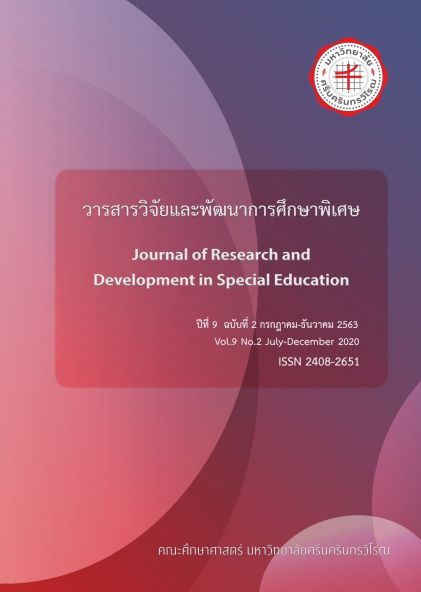การศึกษาการใช้กิจกรรมบูรณาการประสาทสัมผัสเพื่อพัฒนาความสามารถของเด็กออทิสติกระดับปฐมวัย โรงเรียนอุดรเซ็นซอรี จังหวัดอุดรธานี
Abstract
บทคัดย่อ การวิจัยครั้งนี้มีจุดมุ่งหมาย 1) เพื่อศึกษาประสิทธิภาพของกิจกรรมบูรณาการประสาทสัมผัสต่อการพัฒนาความสามารถในการทำกิจกรรมโดยใช้ทักษะของระบบการรับสัมผัสระบบรับรู้กล้ามเนื้อเอ็น และข้อ และระบบการรับรู้การทรงท่าและการเคลื่อนไหว มาใช้บูรณาการร่วมกันของเด็กออทิสติก ระดับปฐมวัยตามเกณฑ์ 80/80 2) เพื่อศึกษาความสามารถในการทำกิจกรรมโดยใช้ทักษะของระบบการรับสัมผัส ระบบรับรู้กล้ามเนื้อเอ็นและข้อ และระบบการรับรู้การทรงท่าและการเคลื่อนไหว มาใช้บูรณาการร่วมกันของเด็กออทิสติก ระดับปฐมวัย และ 3) เพื่อเปรียบเทียบความสามารถทักษะของระบบการรับสัมผัส ระบบรับรู้กล้ามเนื้อเอ็นและข้อ และระบบการรับรู้การทรงท่าและการเคลื่อนไหว ก่อนและหลังเรียนด้วยกิจกรรมบูรณาการประสาทสัมผัสเด็กออทิสติก ระดับปฐมวัย กลุ่มตัวอย่างที่ใช้ในการวิจัยเป็นเด็กออทิสติก ระดับปฐมวัย อายุ 4 - 6 ปี กำลังศึกษาชั้นอนุบาลปีที่ 1 ภาคเรียนที่ 2 ปีการศึกษา 2561 โรงเรียนอุดรเซนซอรี จังหวัดอุดรธานี จำนวน 6 คน โดยใช้วิธีการเลือกแบบเจาะจง (Purposive Sampling) ดำเนินการทดลองเป็นระยะเวลา 4 สัปดาห์ สัปดาห์ละ 4 ครั้ง ครั้งละ 50 นาที รวมทั้งสิ้น 15 ครั้ง เครื่องมือที่ใช้ในการวิจัย คือ 1) แผนการจัดการเรียนรู้กิจกรรมบูรณาการประสาทสัมผัส 2) แบบวัดทักษะความสามารถของเด็กออทิสติก ระดับปฐมวัยด้วยกิจกรรมบูรณาการประสาทสัมผัสระหว่างเรียนและ 3) แบบวัดทักษะความสามารถของเด็กออทิสติก ระดับปฐมวัย ด้วยกิจกรรมบูรณาการประสาทสัมผัสก่อนและหลังเรียน วิเคราะห์ข้อมูลโดยใช้สถิติพื้นฐาน ได้แก่ ค่าเฉลี่ย ค่าร้อยละ และส่วนเบี่ยงเบนมาตรฐาน สถิติที่ใช้เปรียบเทียบ คือ สถิตินอนพาราเมตริก Wilcoxon Signed-Rank Test ผลการวิจัย พบว่า 1) กิจกรรมบูรณาการประสาทสัมผัสต่อการพัฒนาความสามารถประสิทธิภาพมีค่าเท่ากับ 82.32/94.16 ซึ่งมีประสิทธิภาพของผลลัพธ์สูงกว่าเกณฑ์มาตรฐานที่กำหนดไว้ 2) ความสามารถในการทำกิจกรรมโดยใช้ทักษะของระบบการรับสัมผัส ระบบรับรู้กล้ามเนื้อเอ็นและข้อ และระบบการรับรู้การทรงท่าและการเคลื่อนไหว จากกิจกรรมบูรณาการประสาทสัมผัสของเด็กออทิสติก ระดับปฐมวัย อยู่ในระดับดีมาก และ 3) ความสามารถในกิจกรรมบูรณาการประสาทสัมผัสของเด็กออทิสติก ระดับปฐมวัย หลังเรียนแตกต่างจากก่อนเรียนอย่างมีนัยสำคัญทางสถิติที่ระดับ .05 (p-value = .027) คำสำคัญ: กิจกรรมบูรณาการประสาทสัมผัส, เด็กออทิสติก ระดับปฐมวัย ABSTRACT The aim of this research was: 1) to study the effectiveness of using sensory integration therapy programs to improve daily activities performance in sensory systems including; tactile, proprioceptive, vestibular and movement, of the autistic preschoolers, based on 80/80 scale, 2) to study the ability by using tactile, proprioceptive, vestibular and movement of the autistic preschoolers and 3) to compare the ability by using tactile, proprioceptive, vestibular and movement of the autistic preschoolers before and after providing sensory integration therapy programs. Purposive Sampling method was used to conduct this research sample. The subject included six autistic preschoolers, aged between 4 - 6 years old, attending the kindergarten 1, in the second term of the 2018 academic year, from Udon Sensory School in Udonthani Province. This study was conducted for the period of four weeks, four of 50 minute-sessions per week, in a total of fifteen sessions. The research instruments included the following: 1) The Sensory Integration Learning Plan, 2) The Skill Efficiency Evaluation Form for the autistic preschoolers during learning by using activities that support the Sensory Integration Processes, and 3) The Skill Efficiency Evaluation Form for the autistic preschoolers Pre- test and Post-test by using activities that support the Sensory Integration Processes. Basic statistics were used for data analysis such as average values, percentages, and standard deviation. For comparison purpose, non-parametric test called the Wilcoxon Signed-Rank Test was employed. The research results revealed that 1) sensory integration therapy programs used to improve daily activities performance in sensory systems were resulting in 82.31/94.16 and exceeded the standard scale of 80/80, 2) the ability to perform skills using tactile, proprioceptive, vestibular and movement of the autistic preschoolers reached the very good score level, and 3) The ability in sensory integration post-learning skills showed greater difference from the pre-test results; statistically significant difference at 0.05 level (p-value = .027). Keywords: Sensory Integration Therapy, Autistic PreschoolersDownloads
Download data is not yet available.
Downloads
Published
2021-01-16
Issue
Section
Research article




